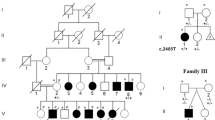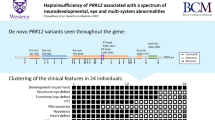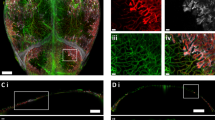Abstract
Craniotubular dysplasia, Ikegawa type (CTDI) is a rare autosomal recessive skeletal dysplasia characterized by hyperostosis of the calvaria and skull base, metadiaphyseal undermodeling of the long tubular bones, and mild shortening and diaphyseal broadening of the short tubular bones. Its causal gene is TMEM53. Six CTDI families have been reported; however, its clinical course and prognosis still remain to be determined. Here, we report two Iranian siblings carrying a novel homozygous missense variant of TMEM53. The affected individuals were referred for progressive severe visual loss of unknown cause. The patient had severe optic atrophy and optic canal narrowing. Radiographic evaluation suggested the diagnosis of CTDI, which was confirmed by the identification of TMEM53 variant (c.704G > T, p.R235L) co-segregating in the consanguineous family. The proband underwent trans-nasal endoscopic optic canal decompression and showed remarkable improvement in visual acuity and daily visual tasks. We recommend early comprehensive clinical and genetic evaluation followed by proper treatment to improve the prognosis of CTDI.
This is a preview of subscription content, access via your institution
Access options
Subscribe to this journal
Receive 12 print issues and online access
269,00 € per year
only 22,42 € per issue
Buy this article
- Purchase on SpringerLink
- Instant access to full article PDF
Prices may be subject to local taxes which are calculated during checkout


Similar content being viewed by others
References
Guo L, Iida A, Bhavani GSL, Gowrishankar K, Wang Z, Xue JY, et al. Deficiency of TMEM53 causes a previously unknown sclerosing bone disorder by dysregulation of BMP-SMAD signaling. Nat Commun. 2021;12:2046. https://doi.org/10.1038/s41467-021-22340-8.
Whyte MP, Weinstein RS, Phillips PH, McAlister WH, Ramakrishnaiah RH, Schaefer GB, et al. Transmembrane protein 53 craniotubular dysplasia (OMIM # 619727): the skeletal disease and consequent blindness of this new disorder. Bone. 2024;188:117218. https://doi.org/10.1016/j.bone.2024.117218.
van Ommeren B, Hoekstra M, van Gassen K, van Jaarsveld R, van Haaften G, Mathijssen I, et al. Craniotubular dysplasia ikegawa type: further delineation of the phenotype. Am J Med Genet A. 2024;0:e63870. https://doi.org/10.1002/ajmg.a.63870.
Wang L, Mizumoto S, Zhang R, Zhang Y, Liu Y, Cheng W, et al. Identification of a novel LFNG variant in a Chinese fetus with spondylocostal dysostosis and a systematic review. J Hum Genet. 2024;69:321–7. https://doi.org/10.1038/s10038-024-01248-3.
Mirdita M, Schütze K, Moriwaki Y, Heo L, Ovchinnikov S, Steinegger M. ColabFold: making protein folding accessible to all. Nat Methods. 2022;19:679–82. https://doi.org/10.1038/s41592-022-01488-1.
Schrodinger, LLC. The fyMOL Molecular Graphics System, Version. 1.3r1.2010. https://www.pymol.org.
Mortier GR, Cohn DH, Cormier‐Daire V, Hall C, Krakow D, Mundlos S, et al. Nosology and classification of genetic skeletal disorders: 2019 revision. Am J Med Genet A. 2019;179:2393–419. https://doi.org/10.1002/ajmg.a.61366.
Pan H, Zhang H, Abraham P, Komatsu Y, Lyons K, Kaartinen V, et al. BmpR1A is a major type 1 BMP receptor for BMP-Smad signaling during skull development. Dev Biol. 2017;429:260–70. https://doi.org/10.1016/j.ydbio.2017.06.020.
Acknowledgements
We thank the patients and their families for their help to the study.
Funding
This study was supported by National Natural Science Foundation of China (Grant No. 82471900, L.G.), Supporting Program of Innovation Capability of Shaanxi Province (2024CX-GXPT-40, L.G.), Provincial Talent Research Support Fund (71240000000131, L.G.), Shaanxi Provincial Project for Innovation Capacity Improvement of Health Research (2024PT-03, R.Q.), Provincial Key Industry Innovation Chain (2024SF-ZDCYL-04-05, R.Q.), and Young Talent Support Plan from Xi’an Jiaotong University (YX6J033, L.G.).
Author information
Authors and Affiliations
Contributions
Long Guo and Niloofar Pirmarzdashti designed the study. Kaitao Ren, Niloofar Pirmarzdashti, Farzad Pakdel, Lin Wang, Moosa Sadrhosseini, Farzane Abassi, Yao Xiong, Jiaqi Han, Lianying Jiao carried out the research. Kaitao Ren, Niloofar Pirmarzdashti, Farzad Pakdel, Jinhui Zhu, Wanqi Liu, Lin Wang, Moosa Sadrhosseini, Farzane Abassi, Yao Xiong, Jiaqi Han, Lianying Jiao, Gen Nishimura, Takahiro Yamada analyzed and interpreted data. Kaitao Ren, Niloofar Pirmarzdashti, Farzad Pakdel drafted the manuscript. Long Guo and Rong Qiang revised it. All authors read and approved the final manuscript.
Corresponding authors
Ethics declarations
Competing interests
The authors declare no competing interests.
Additional information
Publisher’s note Springer Nature remains neutral with regard to jurisdictional claims in published maps and institutional affiliations.
Supplementary information
Rights and permissions
Springer Nature or its licensor (e.g. a society or other partner) holds exclusive rights to this article under a publishing agreement with the author(s) or other rightsholder(s); author self-archiving of the accepted manuscript version of this article is solely governed by the terms of such publishing agreement and applicable law.
About this article
Cite this article
Ren, K., Pirmarzdashti, N., Pakdel, F. et al. A novel missense pathogenic variants of TMEM53 in an Iranian family with craniotubular dysplasia, Ikegawa type. J Hum Genet 70, 195–198 (2025). https://doi.org/10.1038/s10038-025-01319-z
Received:
Revised:
Accepted:
Published:
Issue Date:
DOI: https://doi.org/10.1038/s10038-025-01319-z



